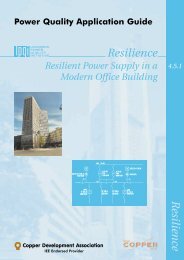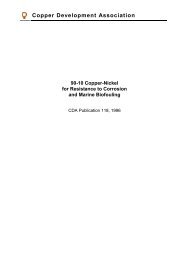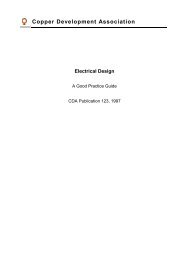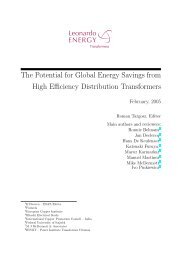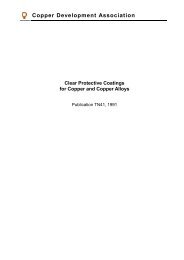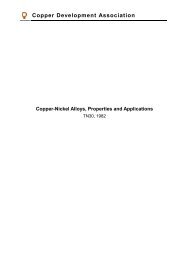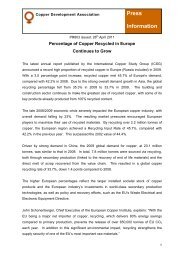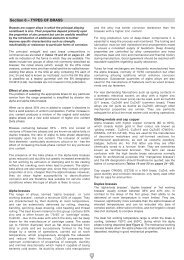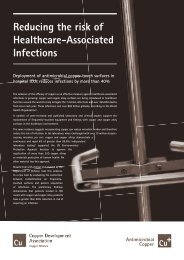Some Domestic Applications for Alpha Alloy Brass Wire
Some Domestic Applications for Alpha Alloy Brass Wire
Some Domestic Applications for Alpha Alloy Brass Wire
Create successful ePaper yourself
Turn your PDF publications into a flip-book with our unique Google optimized e-Paper software.
At Home With <strong>Brass</strong><strong>Some</strong> <strong>Domestic</strong> <strong>Applications</strong> <strong>for</strong> <strong>Alpha</strong><strong>Alloy</strong> <strong>Brass</strong> <strong>Wire</strong>J.E.Nicholson, Technical Sales Manager,Thomas Bolton Copper Products,<strong>Wire</strong> Division.
• Customer Requirements• Metal Melting and Casting• Work Hardening and Softening• Rod Rolling• Annealing• <strong>Wire</strong> Drawing• Electroplating• Selected <strong>Domestic</strong> <strong>Applications</strong>CONTENTS
Customer Requirements• Individual customers can take in one year,lengths of wire that if joined up as one piececould encircle the world.• They demand consistent properties alongthese huge distances.• Ultimate Tensile Strength (range 300 to 850N/mm 2 , tolerances typically +/- 25N/mm 2 )
Customer Requirements cont.• Yield or Proof Strength (range 140 to 830N/mm 2 , tolerances typically +/- 15N/mm 2 )• Electrical Resistivity (range 3.9 to 6.6microhm cm at 20oC, tolerances typically+/- 3% of nominal)• Heading Limit 1.5 to 4.6• Minimal reaction to end use environment.
Effect of Zinc Content on the Formability of <strong>Brass</strong>Single Blow Machines65Heading Limit4321Heading Limit =Maximum Headed Diameter / <strong>Wire</strong> Diameter00 10 20 30 40 50Zinc %
Customer Requirements cont.• Consistency can only be achieved by:• Close control over compositions both withrespect to additions and impurities.• Disciplined production routines managed toISO9000 quality system standards.• The selective use of modern technology.
Metal Melting and Casting.• Metal is melted under nitrogen in a graphitecrucible heated by electrical resistanceelements. There is no oxidation of the melt.• Charges are weighed out with precision toprovide close control over composition.• Liquid metal sinks to the bottom of thecrucible where it is solidified in watercooled dies as 19mm round section.
Metal Melting and Castingcont..........................• As-cast’ rod is pulled through the dies andcoiled <strong>for</strong> convenience.• Long transmission times ensure good alloymixing. Compositional variation typicallyis only 25% of BSEN12166 tolerances.
Metal StoreOnly refined (virtually impurity free) metals and someinternally generated scrap are used to make the alloys.
Coiling CastRodCoils weigh a tonne and are 400metres long.
Work Hardening and Softening.• When metal is bent, stretched or otherwisemanipulated it ‘work hardens’ until itcannot take any more without breaking.• <strong>Brass</strong> can be softened again by heating it toa temperature high enough to cause itscrystal structure to re<strong>for</strong>m, typically 500 o C.• <strong>Wire</strong> is produced from ‘as-cast’ rod by aseries of cold working and annealing cycles.
Work Hardening Curves For Two <strong>Brass</strong> <strong>Alloy</strong>s900800U l t i m a t e T e n s i l e S t r e n g t h N / m m 2700600500400300200100Allo y CuZn30Allo y CuZn1000 10 20 30 40 50 60 70 80% Reduction in Area From Soft Temper.
Rod Rolling.• The first work hardening operation is rodrolling.• A six stand Buhler mill reduces rod sectionfrom 19mm round to 10mm hexagon. Asecond pass takes the wire to 5 mm acrossflats.
Buhler Mill Rod RollingRolling conditions controlled by PC
Annealing• <strong>Alloy</strong>s containing 20% or more zinc areannealed at 10mm and at 5mm.• <strong>Alloy</strong>s containing less than 20% zinc areannealed at 5mm only.• All alloys are also annealed as drawn wireat sizes dictated by the mechanicalproperties specified <strong>for</strong> the end product.
Annealing cont.........................• The mechanical properties of end productsdepends critically on grain size control.• Ebner annealed rod and wire has the samegrain size throughout a 6000kg load andfrom load to load.
Ebner AnnealingSix 1000kg coils or twelve500kg reels are stacked inan Ebner furnace and brightannealed under an atmosphereof 25% hydrogen and 75%nitrogen..At this stage eachreel carries about 500kg ofwire measuring more than30 km in length.
<strong>Wire</strong> Drawing• High speed multi-die wire drawingmachines elongate the wire by reducing itscross-sectional area.• Final reductions in cross-sectional area areselected to give required mechanicalproperties.• Tempers available range from Soft typically300 N/mm 2 to Spring Hard typically850N/mm 2 .
Electroplating• <strong>Brass</strong>es are inherently resistant to a widerange of corrosive environments.• Even better results are obtained when tincoatings are applied.• <strong>Brass</strong>es are easy to join by soldering.• <strong>Wire</strong>s pre-plated with solder over a copperor nickel undercoat are used <strong>for</strong> automatedjoining applications.
Electroplating cont...........• Coatings of uni<strong>for</strong>m thickness are nowapplied using high speed reel to reelmachines.• Coating thickness can be measured tonearest tenth of a micron.
<strong>Domestic</strong> <strong>Applications</strong>: Florescent TubesFour little studs (two at each end) connect fluorescent tubes to theirfittings. A single operation cold extrusion process produces the complexhollow shape from solid wire. CuZn30 was selected because of itsextreme malleability, good corrosion resistance, high electricalconductivity and high strength.
The alkaline cell isbuilt around a centralanode ‘charge collector’made from tin platedCuZn30 wire.The anodes are shapedin the <strong>for</strong>m of nails orrivetsThe application requireslow electrical resistivity,high rigidity, good coldheading properties andzero reaction to thealkaline environment.<strong>Domestic</strong> <strong>Applications</strong>:Alkaline Cells
<strong>Domestic</strong> <strong>Applications</strong>: Gas and WaterFittingsCast iron pipe networks are being replaced with plastic extrusions.Fittings are used to weld one length of pipe to another. <strong>Brass</strong> wire isinlaid in the fitting and acts as an electrical resistance element <strong>for</strong> thewelding process. Tolerance on resistance per metre is only +/3%.Guaranteed <strong>for</strong> fifty years.
<strong>Domestic</strong> <strong>Applications</strong>: Zip FastenersThe selection of materials is at the whim of the designer but CuZn10 andCuZn20 are often used. Flattened wire is fed into cold <strong>for</strong>ming presses.Good malleability is essential. Low zinc brasses are long wearing, strongand most importantly they have a pleasing gold colour although the oneshow above has an ‘antique finish..
CuZn30 and CuZn37 wires areused to hang pictures.The strandedconstruction adds flexibilityto the wires’ high strength.<strong>Domestic</strong> <strong>Applications</strong>: Picture Frame <strong>Wire</strong>
CuZn30 wire <strong>for</strong>ms part of the electrical systemoperating the cord retraction mechanism<strong>Domestic</strong> <strong>Applications</strong>:Vacuum Cleaners
<strong>Domestic</strong> <strong>Applications</strong>:Conclusions<strong>Brass</strong>es have many domestic uses due to aunique combination of properties including:• High strength and good ductility.• Excellent malleability and plasticity.• Easy to weld or solder. Plated option.• Good corrosion resistance. Plated option.• Low electrical resistivity.• Pleasing appearance.
At home with brassThe end………..




